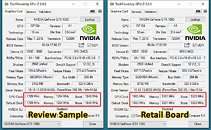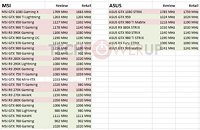Thursday, June 16th 2016
MSI and ASUS Send VGA Review Samples with Higher Clocks than Retail Cards
MSI and ASUS have been sending us review samples for their graphics cards with higher clock speeds out of the box, than what consumers get out of the box. The cards TechPowerUp has been receiving run at a higher software-defined clock speed profile than what consumers get out of the box. Consumers have access to the higher clock speed profile, too, but only if they install a custom app by the companies, and enable that profile. This, we feel, is not 100% representative of retail cards, and is questionable tactics by the two companies. This BIOS tweaking could also open the door to more elaborate changes like a quieter fan profile or different power management.
MSI's factory-overclocked GeForce GTX 1080 Gaming X graphics card comes with three software-defined clock-speed profiles, beginning with the "Gaming Mode," which is what the card runs at, out of the box, the faster "OC mode," and the slower "Silent mode," which runs the card at reference clock speeds. To select between the modes, you're expected to install the MSI Gaming software from the driver DVD, and use that software to apply clock speeds of your desired mode. Turns out, that while the retail cards (the cards you find in the stores) run in "Gaming mode" out of the box, the review samples MSI has been sending out, run at "OC mode" out of the box. If the OC mode is how the card is intended to be used, then why make OC mode the default for reviewers only, and not your own customers?Above, you see two GPU-Z screenshots, one of the TPU review sample, next to the retail board (provided by Nizzen). Flashing the retail BIOS onto our review sample changed the clocks to match exactly what is shown on the GPU-Z retail screenshot.
In case of the GTX 1080 Gaming X, the "Gaming mode" runs the card at 1683 MHz core and 1822 MHz GPU Boost; and the "OC mode" runs it at 1708 MHz core and 1847 MHz GPU Boost. The cards consumers buy will run in the "Gaming mode" out of the box, which presumably is the default factory-overclock of these cards, since they're branded under the "Gaming series."The "OC Mode" is just there so consumers can overclock it a little further at the push of a button, without having any knowledge of overclocking. Now if the OC mode is enabled for review samples of one company and not for the others, this means that potential customers comparing reviews will think one card performs better than the other, even if it's just 1%, people do base their buying decision on such small differences.
With the case of the GTX 1080 at hand, we started looking back at our previous reviews and were shocked to realize that this practice has been going on for years in MSI's case. It looks like ASUS has just adopted it, probably because their competitor does it, too, "so it must be ok."It's also interesting to see that not all cards are affected, whether this is elaborate or by accident is unknown.
While we don't have any statements of the companies yet, the most likely explanation is that reviewers usually don't install any software bundled with the graphics card, yet the companies want the cards to be tested in OC mode, which provides higher performance numbers, beating their competitors. That's probably how this whole thing started, nobody noticed and the practice became standard for reviews moving forward.
This issue could affect upcoming custom GeForce GTX 1070 review samples too, we will be on the lookout.
MSI's factory-overclocked GeForce GTX 1080 Gaming X graphics card comes with three software-defined clock-speed profiles, beginning with the "Gaming Mode," which is what the card runs at, out of the box, the faster "OC mode," and the slower "Silent mode," which runs the card at reference clock speeds. To select between the modes, you're expected to install the MSI Gaming software from the driver DVD, and use that software to apply clock speeds of your desired mode. Turns out, that while the retail cards (the cards you find in the stores) run in "Gaming mode" out of the box, the review samples MSI has been sending out, run at "OC mode" out of the box. If the OC mode is how the card is intended to be used, then why make OC mode the default for reviewers only, and not your own customers?Above, you see two GPU-Z screenshots, one of the TPU review sample, next to the retail board (provided by Nizzen). Flashing the retail BIOS onto our review sample changed the clocks to match exactly what is shown on the GPU-Z retail screenshot.
In case of the GTX 1080 Gaming X, the "Gaming mode" runs the card at 1683 MHz core and 1822 MHz GPU Boost; and the "OC mode" runs it at 1708 MHz core and 1847 MHz GPU Boost. The cards consumers buy will run in the "Gaming mode" out of the box, which presumably is the default factory-overclock of these cards, since they're branded under the "Gaming series."The "OC Mode" is just there so consumers can overclock it a little further at the push of a button, without having any knowledge of overclocking. Now if the OC mode is enabled for review samples of one company and not for the others, this means that potential customers comparing reviews will think one card performs better than the other, even if it's just 1%, people do base their buying decision on such small differences.
With the case of the GTX 1080 at hand, we started looking back at our previous reviews and were shocked to realize that this practice has been going on for years in MSI's case. It looks like ASUS has just adopted it, probably because their competitor does it, too, "so it must be ok."It's also interesting to see that not all cards are affected, whether this is elaborate or by accident is unknown.
While we don't have any statements of the companies yet, the most likely explanation is that reviewers usually don't install any software bundled with the graphics card, yet the companies want the cards to be tested in OC mode, which provides higher performance numbers, beating their competitors. That's probably how this whole thing started, nobody noticed and the practice became standard for reviews moving forward.
This issue could affect upcoming custom GeForce GTX 1070 review samples too, we will be on the lookout.



162 Comments on MSI and ASUS Send VGA Review Samples with Higher Clocks than Retail Cards
Green Team Corps Version
"In brightest day, in blackest night,
No Overclock shall escape my sight.
Let those who worship evil's might
Beware my power--Green Teams overclocking APP's"
Thats almost VW level of shady business.
...
" Hi. I want to order an MSI."
Also, those overclocks are downright pathetic. Three profiles all within 100MHz from each other? And a required app to enable "superior performance"? It's insulting, imo.
Wait for the Forum posts complaining of
"Why will my ***** Nvidia Graphics Card not reach the speeds mentioned in That Review and Test ?
have i been sold a dud have i Been Ripped off "
cross my Palm with Silver !!!
Also noted they are running different BIOS's as well.
I still maintain that review websites should buy the cards themselves from retailers, then invoice the manufacturers for the cost, rather than accept samples directly from manufacturers. That would completely prevent these sort of shenanigans.
So basically, if you want 30MHz more, all you have to do is install a piece of software that is delivered with the card and click one button. Anyone who buys the card has access to this software (and thus the OC clockspeeds), but according to this article, installing the software is something reviewers are refusing to do for reasons not mentioned.
You still install driver software provided with the products, do you not? How is this any different?
As a frequent visitor of this website and reader of its reviews, I'm more surprised to find that many reviews seem to leave out certain aspects of the full product experience available to retail customer like myself.
Which also begs the question:
On the recent products by any of the popular brands like MSI, ASUS and Gigabyte, how do you plan to test the RGB color changing LED functionality without installing the accompanying software? Or is there another way to do this?
I've owned a fair few graphics cards over the years of several brands (including MSI) and usually install the software provided with the products to enjoy the additional functionality it brings. If I choose not to install the software, why would I want to complain about missing the features (or performance) that the free software offers?
The thing is, with dynamic clocks and everything, the profile really doesn't matter, unless it changes the target TDP.
Stupid way to use reputation.